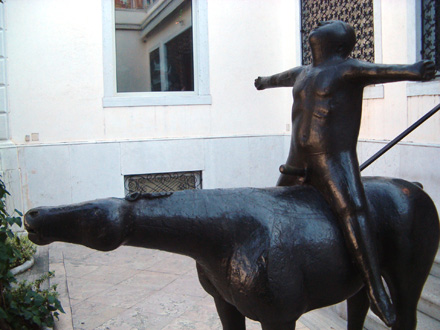Just a cocky rider?
The Peggy Guggenheim Collection in Venice has this sculpture of an apparently aroused man on a horse in the back garden:

The horse has a look of desperation. Here’s a close-up of its head (note that there is a light reflection that makes it look like the horse is looking downward, but if you look closely, you’ll see his pupil as an indentation in the eye – he is actually looking upward):

I always feel out of my element in art museums because I don’t know anything about art. I know I like modern art best, but I rarely feel as though I have any understanding of the point the artist is trying to put across.
When I was in high school, I would argue in English class about poetry. The teacher would always interpret the meaning of the poem in a certain way, typically weighty and metaphysical, which I would dispute.
I wasn’t convinced that poets always had a deeper meaning when they wrote. I thought that maybe Robert Frost’s Stopping by Woods on a Snowy Evening might just really be a poem about a guy out riding his horse.
Whose woods these are I think I know,
His house is in the village though.
He will not see me stopping here,
To watch his woods fill up with snow.My little horse must think it queer,
To stop without a farmhouse near,
Between the woods and frozen lake,
The darkest evening of the year.He gives his harness bells a shake,
To ask if there is some mistake.
The only other sound’s the sweep,
Of easy wind and downy flake.The woods are lovely, dark and deep,
But I have promises to keep,
And miles to go before I sleep,
And miles to go before I sleep.
When I first saw this sculpture I laughed. It seemed goofy, the sort of thing I see in art museums and don’t understand, like Frost’s poem in high school. So I photographed it.
But this sculpture has stuck in my mind, more than any other artwork I think I’ve ever seen. So without knowing a thing about it, I will attempt an interpretation of it, which I will then compare to an interpretation by an expert, if I can find one. Here goes.
The sculpture shows man’s willingness to subjugate others even as he himself is ruled by a higher power (or a belief in one).
The man’s arms are extended in the form of a cross, and he looks upward. His expression is resolute but also supplicant, as though he is asking for something only god can give him but is steadfastly certain that god will do so. He is dependent but also filled with confidence.
His head faces one way but his penis points in a different direction – “the spirit indeed is willing but the flesh is weak” (Matthew 26:41). Like his relationship with god, his relationship with his penis is characterized by dependency but it also drives him forward – thrusts him forward, you might say.
Beneath all this, the horse is suffering. He is driven forward by the man on top, but he enjoys none of the confidence that the man does, because he has no faith in the man. He is unable to escape his fate and knows it will likely be grim.
The horse represents both nature and man’s domination of it, and man’s domination of those people that are weaker than him.
That’s my take, now let’s see what others have to say. The sculpture is called The Angel of the City (L’angelo della citta ) by Marino Marini (try saying his name out loud, it’s pure honey). Here’s a description of some his work:
The evolution of the subject of the horse and rider reflects Marini’s personal response to that changing context. The theme first appears in his work in 1936, when the proportions of horse and rider are relatively slender and both figures are poised, formal, and calm. By the following year the horse rears and the rider gestures.
In 1940 the forms become simplified and more archaic in spirit, and the proportions become squatter. By the late 1940s the horse is planted immobile with its neck extended, strained, ears pinned back, and mouth open, as in the present example, which conveys the qualities characteristic of this period of Marini’s work – affirmation and charged strength associated explicitly with sexual potency.
Later, the rider becomes increasingly oblivious of his mount, involved in his own visions or anxieties. Eventually he was to topple from the horse as it fell to the ground in an apocalyptic image of lost control, paralleling Marini’s feelings of despair and uncertainty about the future of the world.
That’s about all I found. I’m not sure if my interpretation holds up or not. In the process of seeking meaning in this piece, however, I think I’ve learned a little bit about art.
[tags]modern art, art, sculpture, guggenheim, Venice[/tags]
 twitter.com/adriandz
twitter.com/adriandz
